Sopra Steria Group Bundle
Who Really Owns Sopra Steria Group?
Ever wondered who pulls the strings at a European tech giant like Sopra Steria Group? Understanding the Sopra Steria Group SWOT Analysis is crucial, but it all starts with ownership. Unraveling the Sopra Steria ownership structure unveils the forces shaping its strategic decisions and market performance. This deep dive will illuminate the key players influencing this major player in the digital transformation landscape.
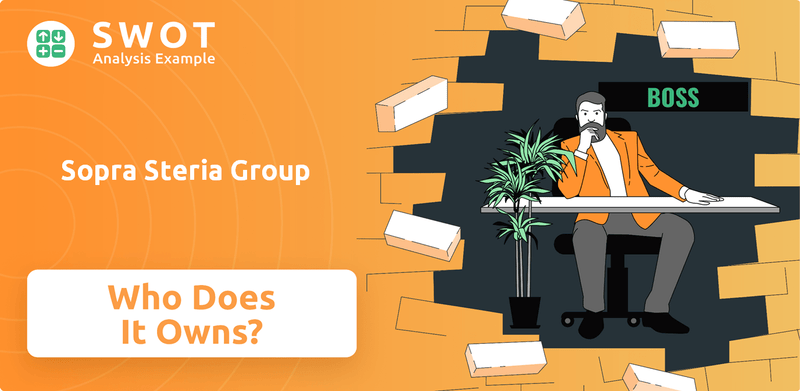
From its formation through the merger of Sopra and Steria, the Sopra Steria parent company has seen significant shifts in its shareholder base. Knowing who the Sopra Steria shareholders are, and how they influence the company, is vital for anyone analyzing the company's future. This exploration of Sopra Steria ownership history will provide insights into the company's governance and strategic focus, shedding light on its journey to becoming a leading IT services provider. This includes understanding if Sopra Steria is a public company and who the key executives are.
Who Founded Sopra Steria Group?
The story of Sopra Steria Group begins with its founders. Understanding the initial ownership structure provides insight into the company's early development and its evolution into a major player in the IT services sector. This foundation is crucial for grasping the current Sopra Steria ownership and its strategic direction.
Sopra was established in January 1968. Steria, on the other hand, was founded in 1969. The early years of both companies set the stage for their future growth and eventual merger, shaping the Sopra Steria Group we know today. This early ownership and the strategic decisions made during this period are key to understanding the company's trajectory.
Pierre Pasquier, François Odin, and Léo Gantelet founded Sopra in Annecy, France. Jean Carteron founded Steria. Pasquier, a mathematics graduate, brought experience from Bull, fostering innovation and client service. These founders were instrumental in developing the companies.
Sopra was established in January 1968 in Annecy, France. The founders were Pierre Pasquier, François Odin, and Léo Gantelet.
Steria was founded in 1969 by Jean Carteron. This marked the beginning of Steria's journey in the IT sector.
Shortly after its creation, SODERI held 51% of Sopra. BNP Group held 29.5%, and Indochina Group held 19.5%.
By 1971, Sopra secured its first major global banking managed services agreement. Steria computerised Agence France-Presse in 1973.
Sopra focused on banking, utilities, services, telecom, retail, and public sectors. It also developed proprietary solutions.
Pierre Pasquier, a mathematics graduate, brought an entrepreneurial spirit to Sopra. His experience at Bull was also significant.
The early ownership structure of Sopra, with SODERI, BNP Group, and Indochina Group, highlights the initial financial backing and strategic partnerships. The development of the first banking platform in 1972 and Steria's computerization of Agence France-Presse in 1973 demonstrate early successes. For more insights into the competitive environment, you can read about the Competitors Landscape of Sopra Steria Group.
Understanding the early ownership of Sopra Steria Group is crucial for grasping its current structure. Here are some key takeaways:
- Sopra was founded in January 1968 by Pierre Pasquier, François Odin, and Léo Gantelet.
- Steria was founded in 1969 by Jean Carteron.
- Early ownership of Sopra included SODERI (51%), BNP Group (29.5%), and Indochina Group (19.5%).
- Sopra secured its first major global banking managed services agreement in 1971.
- Steria computerised Agence France-Presse in 1973.
Sopra Steria Group SWOT Analysis
- Complete SWOT Breakdown
- Fully Customizable
- Editable in Excel & Word
- Professional Formatting
- Investor-Ready Format
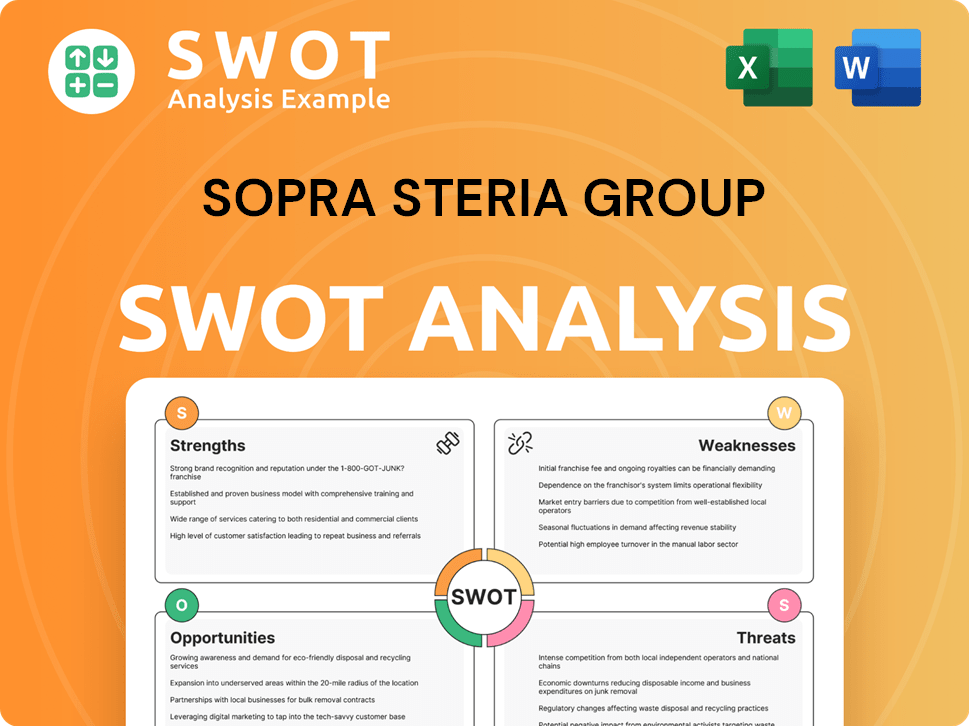
How Has Sopra Steria Group’s Ownership Changed Over Time?
The evolution of Sopra Steria Group's ownership is marked by key events, most notably the 2014 merger of Sopra and Steria, which formed the current entity. Before this merger, Sopra initiated its Initial Public Offering (IPO) on NYSE Euronext Paris in 1990, and Steria followed with its IPO in 1999. These initial public offerings set the stage for the ownership structure that exists today, with a blend of public and private interests shaping the company's trajectory.
The ownership structure reflects a balance between public and strategic shareholders. The company's Growth Strategy of Sopra Steria Group has been influenced by these ownership dynamics, including the sale of Sopra Banking Software activities in September 2024.
| Shareholder | Shareholding (%) | Theoretical Voting Rights (%) |
|---|---|---|
| Sopra GMT | 19.6% | 29.9% |
| Founders and Management | 2.6% | 3.8% |
| Shares managed on behalf of employees | 6.0% | 8.1% |
| Treasury shares | 4.9% | |
| Public (Free Float) | 66.8% | 54.5% |
As of April 30, 2025, the major shareholders of Sopra Steria Group include Sopra GMT, which holds a significant portion of shares and voting rights, primarily owned by the Pasquier and Odin families, along with One Equity Partners. Founders and management also hold a direct stake, while employees collectively represent the second-largest shareholder group through shares managed on their behalf. The public, or free float, constitutes the largest shareholder group, ensuring a significant level of market influence. These elements collectively shape the Sopra Steria ownership structure.
The ownership structure of Sopra Steria Group is a blend of public and strategic shareholders, with a significant portion held by the founding families through Sopra GMT.
- Sopra GMT is the core shareholder, with a substantial influence on voting rights.
- Employees are the second-largest shareholder group.
- The public holds the largest portion of shares, ensuring market influence.
- The presence of One Equity Partners indicates private equity involvement.
Sopra Steria Group PESTLE Analysis
- Covers All 6 PESTLE Categories
- No Research Needed – Save Hours of Work
- Built by Experts, Trusted by Consultants
- Instant Download, Ready to Use
- 100% Editable, Fully Customizable
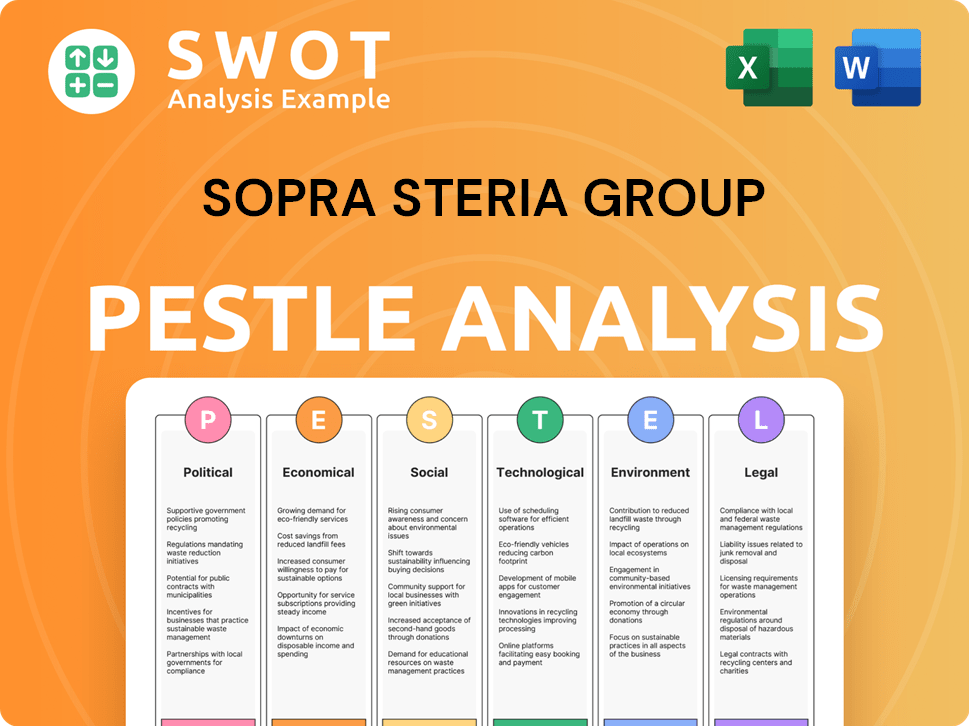
Who Sits on Sopra Steria Group’s Board?
The Board of Directors of Sopra Steria plays a vital role in its governance, with its composition reflecting the company's ownership structure. Pierre Pasquier, a co-founder of Sopra, chairs the Board. Éric Hayat, a co-founder of Groupe Steria, serves as Vice-Chairman of the Board since the 2014 merger. As of April 9, 2025, the board members include a mix of founders, representatives of major shareholders, and independent directors. The average tenure of the board is 10.5 years, indicating an experienced board.
The board's composition and the voting structure are key elements of Sopra Steria's corporate governance. The presence of both founders and representatives of major shareholders on the board, along with independent directors, suggests a balance between the interests of different stakeholders. This structure aims to ensure effective oversight and strategic direction for the company. Understanding the board's composition is crucial for assessing the company's strategic direction and its responsiveness to shareholder interests. The Annual General Meeting is scheduled for May 21, 2025.
| Board Member | Role | Notes |
|---|---|---|
| Pierre Pasquier | Chairman | Co-founder of Sopra |
| Éric Hayat | Vice-Chairman | Co-founder of Groupe Steria |
| Board Members | Diverse | Founders, major shareholders, and independent directors |
The voting structure of Sopra Steria is influenced by differential voting rights. As of April 30, 2025, Sopra GMT holds 19.6% of the shares but commands 29.9% of the theoretical voting rights. Shares managed on behalf of employees represent 6.0% of shares but hold 8.1% of theoretical voting rights. As of May 31, 2025, the total number of shares is 20,547,701, with a theoretical number of voting rights at 26,592,712, and the number of exercisable voting rights at 25,571,619. This suggests a dual-class share structure or similar arrangements that grant more voting power per share to certain long-term or strategic shareholders, such as the founding families and employee share schemes, compared to the general public float.
Understanding the ownership structure and voting rights is crucial for investors and stakeholders. The company's governance structure includes founders, major shareholders, and independent directors. The Annual General Meeting is scheduled for May 21, 2025.
- Sopra GMT holds 19.6% of the shares, controlling 29.9% of the theoretical voting rights.
- Employee shares represent 6.0% of shares, holding 8.1% of theoretical voting rights.
- The total number of shares is 20,547,701.
- The theoretical number of voting rights is 26,592,712.
Sopra Steria Group Business Model Canvas
- Complete 9-Block Business Model Canvas
- Effortlessly Communicate Your Business Strategy
- Investor-Ready BMC Format
- 100% Editable and Customizable
- Clear and Structured Layout
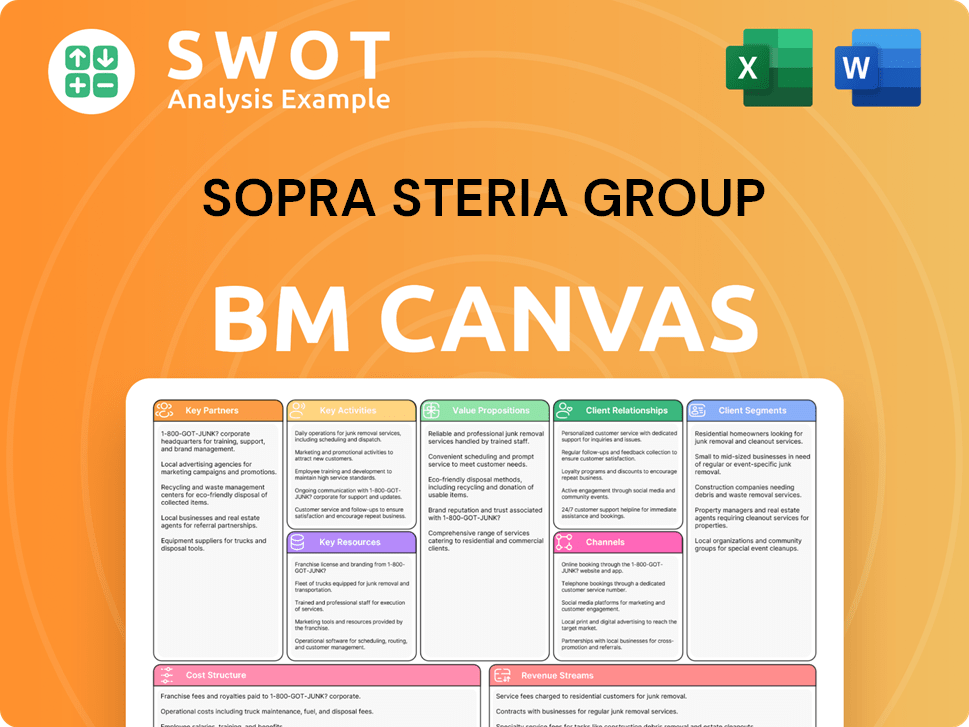
What Recent Changes Have Shaped Sopra Steria Group’s Ownership Landscape?
Over the past few years, several strategic shifts have reshaped the ownership landscape of the Sopra Steria Group. A notable move was the completion of a share buyback program, which began on October 2, 2024, and concluded on January 28, 2025. During this period, the company repurchased 858,163 shares, representing 4.2% of its capital, at an average price of €174.79 per share. These shares are slated for retirement in 2025, a move designed to decrease the total outstanding shares and potentially boost earnings per share. This program followed the finalization of the sale of Sopra Banking Software activities on September 2, 2024, which generated €410.5 million for the Group. These actions reflect the company's strategy to focus on digital services and solutions.
Further influencing the Sopra Steria ownership structure are acquisitions, such as the planned acquisition of Aurexia, a financial services management consulting firm, announced on January 30, 2025, and finalized on May 1, 2025. This acquisition is intended to strengthen Sopra Steria Next's consulting business, with an aim to double its size by 2028. These strategic moves underscore the trend of consolidation within the industry and the strengthening of high-value consulting services. Leadership changes, like the appointment of Dominique Lapère as COO in October 2024, also indicate a focus on operational efficiency.
| Metric | Details | Year |
|---|---|---|
| Share Buyback Program | Repurchased 858,163 shares | 2024-2025 |
| Average Share Price (Buyback) | €174.79 | 2024-2025 |
| Sale of Sopra Banking Software | Generated €410.5 million | 2024 |
| Dividend per Share | €4.65 | 2024 |
The company's strategic plan for 2025-2027, presented in December 2024, outlines ambitious goals, including annual organic revenue growth of 2% to 5% post-2025 and approximately €1 billion in acquired revenue between 2024 and 2028. These targets, along with the aim to increase the consulting business to at least 12% of Group revenue by 2028, highlight its commitment to organic growth and strategic acquisitions. These developments are crucial for understanding the dynamics of Sopra Steria's ownership and its future trajectory. For more insights, consider exploring the Growth Strategy of Sopra Steria Group.
The ownership structure includes a mix of institutional investors, and potentially, individual shareholders. The company's strategic decisions are influenced by its major investors, as well as its executive leadership.
Key executives include the CEO, Cyril Malargé, and the COO, Dominique Lapère. Their decisions and strategies directly impact the company's performance and direction.
Yes, Sopra Steria Group is headquartered in France. It operates globally but has its roots and primary listing in France.
Contact information for investor relations can be found on the official Sopra Steria website, usually under the 'Investors' or 'Financial Information' section.
Sopra Steria Group Porter's Five Forces Analysis
- Covers All 5 Competitive Forces in Detail
- Structured for Consultants, Students, and Founders
- 100% Editable in Microsoft Word & Excel
- Instant Digital Download – Use Immediately
- Compatible with Mac & PC – Fully Unlocked
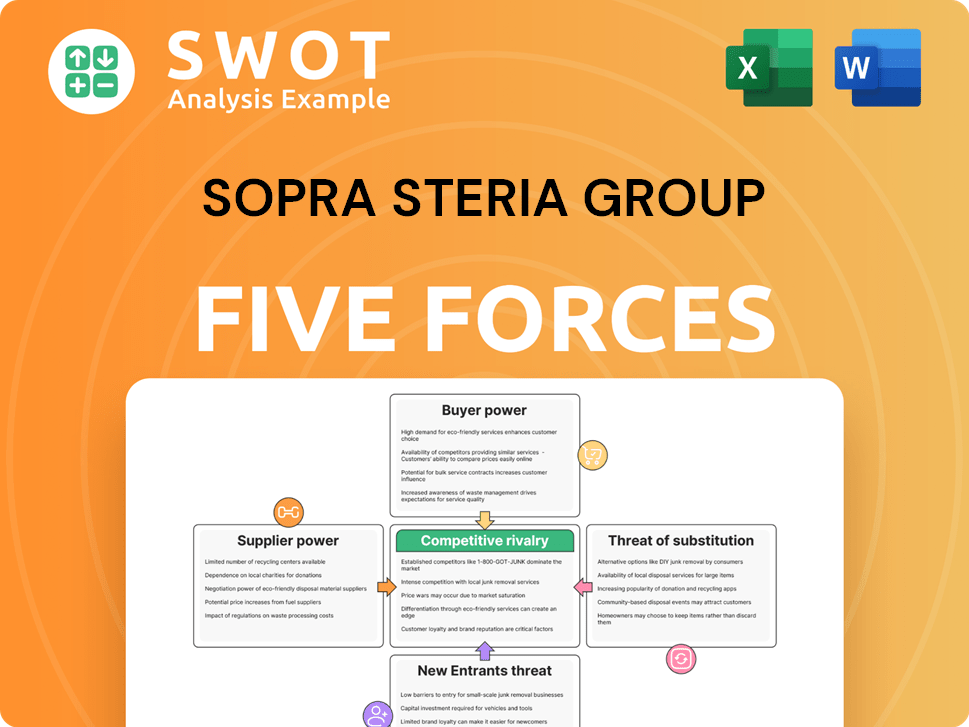
Related Blogs
- What are Mission Vision & Core Values of Sopra Steria Group Company?
- What is Competitive Landscape of Sopra Steria Group Company?
- What is Growth Strategy and Future Prospects of Sopra Steria Group Company?
- How Does Sopra Steria Group Company Work?
- What is Sales and Marketing Strategy of Sopra Steria Group Company?
- What is Brief History of Sopra Steria Group Company?
- What is Customer Demographics and Target Market of Sopra Steria Group Company?
Disclaimer
All information, articles, and product details provided on this website are for general informational and educational purposes only. We do not claim any ownership over, nor do we intend to infringe upon, any trademarks, copyrights, logos, brand names, or other intellectual property mentioned or depicted on this site. Such intellectual property remains the property of its respective owners, and any references here are made solely for identification or informational purposes, without implying any affiliation, endorsement, or partnership.
We make no representations or warranties, express or implied, regarding the accuracy, completeness, or suitability of any content or products presented. Nothing on this website should be construed as legal, tax, investment, financial, medical, or other professional advice. In addition, no part of this site—including articles or product references—constitutes a solicitation, recommendation, endorsement, advertisement, or offer to buy or sell any securities, franchises, or other financial instruments, particularly in jurisdictions where such activity would be unlawful.
All content is of a general nature and may not address the specific circumstances of any individual or entity. It is not a substitute for professional advice or services. Any actions you take based on the information provided here are strictly at your own risk. You accept full responsibility for any decisions or outcomes arising from your use of this website and agree to release us from any liability in connection with your use of, or reliance upon, the content or products found herein.